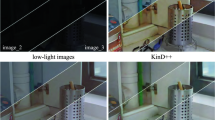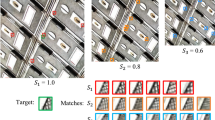Abstract
In this paper, we propose an efficient no-reference image quality assessment (NR-IQA) method dubbed Center-Surround based Blind Image Quality Assessment (CS-BIQA). Our proposed method employs the Difference of Gaussian (DoG) model to decompose images into several frequency bands, considering the center-surround effect and multi-channel attribute of human visual system (HVS). The integrated natural scene statistics (NSS) features can be further derived from all DoG bands. After that, regression models between the integrated features and associated subjective assessment scores are learned on the training dataset. Subsequently, the learned models are used to predict the quality scores of test images. The main contribution of this paper is twofold. Firstly, the empirical distributions of DoG bands of images are proven to be a Gaussian-like distribution. And thus, the NSS features can be employed to represent the perceptual quality of images. Secondly, different types of distortions are observed to affect different frequency components of images. So, the integrated features extracted from multi-frequency bands are employed in CS-BIQA to achieve stronger distinguishable capability of image quality. Excessive experiments are conducted to indicate that our proposed CS-BIQA metric can represent the perceptual characteristics of HVS. The results on popular IQA databases demonstrate that the CS-BIQA metric is competitive with the state-of-the-art relevant IQA metrics. Furthermore, our proposed method has very low computational complexity, making it more suitable for real-time applications.






Similar content being viewed by others
References
Adelson EH (2000) Lightness perception and lightness illusions, chap 24. MIT, Cambridge, pp 339–351
Bovik AC (2013) Automatic prediction of perceptual image and video quality. Proc. IEEE 101(9):2008–2024
Chang CC, Lin CJ (2011) LIBSVM: a library for support vector machines. ACM Trans Intell Syst Technol 2:27:1–27:27. Software available at http://www.csie.ntu.edu.tw/~cjlin/libsvm
Ciancio A, Da CA, Da SE, Said A, Samadani R, Obrador P (2011) No-reference blur assessment of digital pictures based on multifeature classifiers. IEEE Trans Image Process 20(1):64
Fu Y, Wang S (2016) A no reference image quality assessment metric based on visual perception. Algorithms 9(4)
Ghadiyaram D, Bovik AC (2015) Feature maps driven no-reference image quality prediction of authentically distorted images. Proc SPIE - Int Soc Optl Eng 9394:93,940J–93,940J–14
Ghadiyaram D, Bovik AC (2016) Perceptual quality prediction on authentically distorted images using a bag of features approach. J Vis 17(1)
Gu K, Liu M, Zhai G, Yang X (2015) Quality assessment considering viewing distance and image resolution. IEEE Trans Broadcast 61(3):520–531
Gu K, Zhai G, Yang X, Zhang W (2015) Using free energy principle for blind image quality assessment. IEEE Trans Multimed 17(1):50–63
Gu K, Lin W, Zhai G, Yang X, Zhang W, Chang W (2016) No-reference quality metric of contrast-distorted images based on information maximization. IEEE Trans Cybern 1–7
Gu K, Zhai G, Lin W, Liu M (2016) The analysis of image contrast: from quality assessment to automatic enhancement. IEEE Trans Cybern 46(1):284
Gu K, Li L, Lu H, Xin X, Lin W (2017) A fast reliable image quality predictor by fusing micro- and macro-structures. IEEE Trans Indus Electron
Gu K, Tao D, Qiao J, Lin W (2017) Learning a no-reference quality assessment model of enhanced images with big data. IEEE Trans Neural Netw Learn Syst
Jayaraman D, Mittal A, Moorthy AK, Bovik AC (2012) Objective quality assessment of multiply distorted images. In: Conference record of the forty sixth asilomar conference on signals, systems and computers, pp 1693–1697
Larson EC, Chandler DM (2010) Most apparent distortion: full-reference image quality assessment and the role of strategy. J Electron Imag 19(1):143–153
Li L, Zhou Y, Lin W, Wu J, Zhang X, Chen B (2016) No-reference quality assessment of deblocked images. Neurocomputing 177(C):572–584
Lin YH, Wu JL (2014) Quality assessment of stereoscopic 3d image compression by binocular integration behaviors. IEEE Trans Image Process 23(4):1527–1542
Liu H, Klomp N, Heynderickx I (2010) A no-reference metric for perceived ringing artifacts in images. IEEE Trans Circ Syst Vid Technol 20(4):529–539
Lu W, Xu T, Ren Y, He L (2016) Statistical modeling in the shearlet domain for blind image quality assessment. Multimed Tools Appl 75(22):1–15
Mittal A, Moorthy AK, Bovik AC (2012) No-reference image quality assessment in the spatial domain. IEEE Trans Image Process 21(12):4695–4708
Mittal A, Soundararajan R, Bovik AC (2013) Making a “completely blind” image quality analyzer. IEEE Signal Process Lett 20(3):209–212
Moorthy AK, Bovik AC (2010) A two-step framework for constructing blind image quality indices. IEEE Signal Process Lett 17(5):513–516
Moorthy AK, Bovik AC (2011) Blind image quality assessment: from natural scene statistics to perceptual quality. IEEE Trans Image Process 20(12):3350–64
Pei SC, Chen LH (2015) Image quality assessment using human visual dog model fused with random forest. IEEE Trans Image Process 24(11):3282–92
Ponomarenko N, Lukin V, Zelensky A, Egiazarian K, Carli M, Battisti F (2004) TID2008 - a database for evaluation of full-reference visual quality assessment metrics. Adv Modern Radioelectron 10:30–45
Ponomarenko N, Leremeiev O, Lukin V, Egiazarian K, Jin L, Astola J, Vozel B, Chehdi K, Carli M, Battisti F (2013) Color image database TID2013: peculiarities and preliminary results. In: European workshop on visual information processing, pp 106–111
Ruderman DL (2009) The statistics of natural images. Netw Comput Neural Syst 5(4):517–548
Saad MA, Bovik AC, Charrier C (2010) A DCT statistics-based blind image quality index. IEEE Signal Process Lett 17(6):583–586
Saad MA, Bovik AC, Charrier C (2012) Blind image quality assessment: a natural scene statistics approach in the DCT domain. IEEE Trans Image Process 21(8):3339–52
Shao F, Li K, Lin W, Jiang G, Yu M (2015) Using binocular feature combination for blind quality assessment of stereoscopic images. IEEE Signal Process Lett 22(10):1548–1551
Sharifi K, Leongarcia A (1995) Estimation of shape parameter for generalized gaussian distributions in subband decompositions of video. IEEE Trans Circ Syst Vid Technol 5(1):52–56
Tang L, Li Q, Li L, Gu K, Qian J (2017) Training-free referenceless camera image blur assessment via hypercomplex singular value decomposition. Multimed Tools Appl 1–22
Wang Z, Bovik AC, Sheikh HR, Simoncelli EP (2004) Image quality assessment: from error visibility to structural similarity. IEEE Trans Image Process 13(4):600–612
Wang S, Ma K, Yeganeh H, Wang Z (2015) A patch-structure representation method for quality assessment of contrast changed images. IEEE Signal Process Lett 22(12):2387–2390
Xu J, Ye P, Li Q, Du H (2016) Blind image quality assessment based on high order statistics aggregation. IEEE Trans Image Process 25(9):4444–4457
Zhang L, Zhang L, Bovik AC (2015) A feature-enriched completely blind image quality evaluator. IEEE Trans Image Process 24(8):2579–2591
Acknowledgements
This work is partly supported by the Doctorate Foundation of Northwestern Polytechnical University (CX201423), the Fundamental Research Funds of Northwestern Polytechnical University (NO.G2015KY0302), the National Aerospace Science and Technology Foundation and the National Nature Science Foundation of China (NO. 61702419).
Author information
Authors and Affiliations
Corresponding author
Rights and permissions
About this article
Cite this article
Wu, J., Xia, Z., Li, H. et al. No-reference image quality assessment with center-surround based natural scene statistics. Multimed Tools Appl 77, 20731–20751 (2018). https://doi.org/10.1007/s11042-017-5483-2
Received:
Revised:
Accepted:
Published:
Issue Date:
DOI: https://doi.org/10.1007/s11042-017-5483-2




